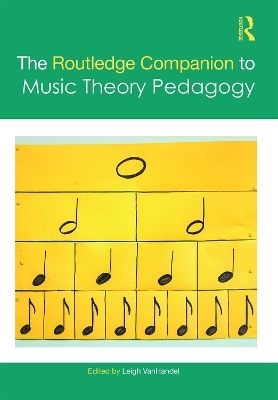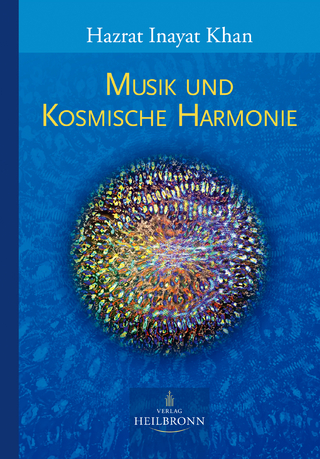
The Routledge Companion to Music Theory Pedagogy
Routledge (Verlag)
978-1-138-58501-0 (ISBN)
This volume takes a unique approach to provide resources for both the conceptual and pragmatic sides of music theory pedagogy. Each section includes thematic "anchor" chapters that address key issues, accompanied by short "topics" chapters offering applied examples that instructors can readily adopt in their own teaching. In eight parts, leading pedagogues from across North America explore how to most effectively teach the core elements of the music theory curriculum:
Fundamentals
Rhythm and Meter
Core Curriculum
Aural Skills
Post-Tonal Theory
Form
Popular Music
Who, What, and How We Teach
A broad musical repertoire demonstrates formal principles that transcend the Western canon, catering to a diverse student body with diverse musical goals. Reflecting growing interest in the field, and with an emphasis on easy implementation, The Routledge Companion to Music Theory Pedagogy presents strategies and challenges to illustrate and inspire, in a comprehensive resource for all teachers of music theory.
Leigh VanHandel is Associate Professor of Music Theory at the University of British Columbia.
PART I: Fundamentals / 1. Music theory and working memory (Leigh VanHandel) / 2. Putting the music in "music fundamentals" (Melissa Hoag) / 3. A cornucopia of accidentals (Paula J. Telesco) / 4. Contouring as a powerful tool for pitch awareness (Jan Miyake) / 5. Incorporating melodicas into the music theory classroom (Chelsey L. Hamm) / 6. Music fundamentals games (Stefanie Dickinson) / PART II: Rhythm and Meter / 7. Introducing musical meter through perception (Stanley V. Kleppinger) / 8. Starting from scratch: Representing meter using simple programming tools (Daniel B. Stevens) / 9. ‘Computer programmed with just one finger’: Transcribing rap beats with the Roland TR–808 (Michael Berry) / 10. Rebeaming rhythms: Helping students ‘feel’ the need for correct beaming (Gene S. Trantham) / 11. Clapping for credit: A pedagogical application of Reich’s Clapping Music (Jon Kochavi) / 12. Hindustani Tal: Non-Western explorations of meter (Anjni H. Amin) / PART III: Core Curriculum / Diatonic Harmony / 13. Small-scale improvisation in the music theory classroom (Nancy Rogers) / 14. The cognitive and communicative constraints of part-writing (Daniel Shanahan) / 15. Voice-leading detectives (Meghan Naxer) / 16. Harmonic sequences simplified: The first week of instruction (Brent Auerbach) / 17. Grading the song (Michael Baker) / 18. Finding the implied polyphony in the Minuet II from Bach’s Cello Suite No. 1 in G Major (Edward Klorman) / Chromatic Harmony / 19. Using tendency tones to teach the morphology and syntax of chromatic harmony (Stacey Davis) / 20. Apply yourself! An active learning lesson plan for introducing secondary dominants (Patricia Burt) / 21. Plot twists: Narrative pivots and the enharmonic augmented sixth chord (Jena Root) / 22. Chromatic mediants through the context of film music (Erik Heine) / 23.How to analyze chromatic lament-bass harmonizations (without tears) (Jason Britton) / 24. Introduction to common-tone diminished-seventh chords (Nicole Biamonte) / 25. ‘It’s an N, bro’: Teaching enharmonic reinterpretation of fully diminished seventh chords by ear (David Heetderks) / PART IV: Aural Skills / 26. Defending the straw man: Modulation, solmization, and what to do with a brain (Gary S. Karpinski) / 27. Speaking Music (Justin Mariner/Peter Schubert) / 28. Finding your way home: Methods for finding tonic (Tim Chenette) / 29. Error detection in aural skills classes (Alexandrea Jonker) / 30. In search of hidden treasures: An exercise in symphonic hearing (Daniel B. Stevens) / 31. An aural skills introduction to twelve tone music: Dallapiccola’s ‘Vespro, Tutto Riporti’ (David Geary) / PART V: Post-Tonal Theory / 32. Setting sets aside: Prioritizing motive, text, and diversity in post-tonal analysis courses (Michael Buchler) / 33. Teaching and learning early twentieth century techniques at the keyboard (Lynnsey J. Lambrecht) / 34. Starting the twentieth century with a bang! A lesson plan for whole-tone scales in Tosca (Christopher Doll) / 35. 20th-century Polymodality: Scalar Layering, Chromatic Mismatch, and Symmetry (José Antonio Martins) / 36. Twelve-tone study using symbols in Dallapiccola’s ‘Fregi,’ from Quaderno Musicale di Annalibera (Joe Argentino) / 37. Integral serialism – analysis of Gerhard, String Quartet No. 1, mvt. 3 (Rachel Mann) / 38. Mapping symmetry and form in George Crumb’s "A Prophecy of Nostradamus" (Natalie Williams) / PART VI: Form / 39. Principles of form (Áine Heneghan) / 40. Recomposing phrase structure (Eric Hogrefe) / 41. Teaching musical structure through Disney songs (Andrew Vagts/Douglas Donley) / 42. From theory to practice: How to compose a sentence (Andrew Schartmann) / 43. Incorporating Latin-American popular music in the study of musical form (Gabriel Navia and Gabriel Ferrão Moreira) / 44. Binary form through the music of underrepresented composers (Victoria Malawey) / 45. A form-functional approach to binary form analysis (Andreas Metz) / 46. Exploring ternary form through the lens of analysis–performance in a Mozart aria (Betsy Marvin) / 47. Sonata-allegro form: Understanding the drama (Tom Childs) / 48. Concerto form: Transforming a sonata into a concerto (Patrick Johnson) / PART VII: Popular Music / 49. Popular music in the classroom (John Covach) / 50. The Beatles’ ‘Day Tripper’: A tortured stretching of the twelve-bar blues (Walter Everett) / 51. Making borrowed chords pop: teaching modal mixture through popular music (Josh Albrecht) / 52. Chromatic mediants in popular music (Victoria Malawey) / PART VIII: Who, What, and How We Teach / 53. Challenges and opportunities of teaching music theory at community colleges (and elsewhere) (Nathan Baker) / 54. More than just four chords: teaching music theory/aural skills to music industry majors (Jennifer Snodgrass) / 55. Instructing a range of experience within the music theory classroom (Cora S. Palfy) / 56. Music theory pedagogy and public music theory (J. Daniel Jenkins) / 57. Analytical podcasting (William O’Hara) / 58. Designing for access in the classroom and beyond (Jennifer Iverson) / 59. Music analysis and accessibility in the music theory classroom (Shersten Johnson) / 60. Accommodating dyslexia in aural skills: A case study (Charlene Romano) / 61. Writing exams cooperatively with students (Jan Miyake) / 62. What should an undergraduate music theory curriculum teach? (And, alas, what most of the time we don’t) (Justin London) / 63. Strategies for revising music curricula for the 21st century: a case study (Deborah Rifkin) / 64. Putting it together: Rethinking the theory curriculum (Matthew Heap) / 65. Adapting the aural skills curriculum: a move away from ‘the’ right answer (Susan M. Piagentini) / 66. Cultivating creativity: Questions, relevance, and focus in the theory classroom (Philip Duker) / 67. Using video technology in music theory assignments (Marcelle Pierson) / 68. Incorporating improvisation in a theory class on contemporary music (Cynthia Folio)
| Erscheinungsdatum | 26.02.2020 |
|---|---|
| Reihe/Serie | Routledge Music Companions |
| Zusatzinfo | 15 Tables, black and white; 140 Line drawings, black and white; 4 Halftones, black and white |
| Verlagsort | London |
| Sprache | englisch |
| Maße | 178 x 254 mm |
| Gewicht | 1090 g |
| Themenwelt | Kunst / Musik / Theater ► Musik ► Musiktheorie / Musiklehre |
| Sozialwissenschaften ► Pädagogik | |
| ISBN-10 | 1-138-58501-7 / 1138585017 |
| ISBN-13 | 978-1-138-58501-0 / 9781138585010 |
| Zustand | Neuware |
| Informationen gemäß Produktsicherheitsverordnung (GPSR) | |
| Haben Sie eine Frage zum Produkt? |
aus dem Bereich


